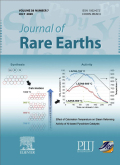- 钛学术文献服务平台 \
- 学术期刊 \
- 工业技术期刊 \
- 冶金工业期刊 \
- 稀土学报(英文版)期刊 \
Solvent extraction and separation of light rare earths from chloride media using HDEHP-P350 system
Solvent extraction and separation of light rare earths from chloride media using HDEHP-P350 system
基本信息来源于合作网站,原文需代理用户跳转至来源网站获取
摘要:
Solvent extraction is the most important method for rare earth extraction and separation.Currently,di(2-ethylhexyl) phosphoric acid (HDEHP) and 2-ethylhexyl phosphonic acid mono-2-ethylhexyl ester (HEH/EHP) are widely used in industrial production,but there are still obvious deficiencies that require further research to resolve.In this paper,the unsaponification extraction of light rare earth ions in a hydrochloric acid medium by di(2-ethylhexyl) phosphoric acid-di(1-methyl-heptyl) methyl phosphonate (HDEHP-P350) system was studied.The results show that the addition of P350 reduces the extraction capacity of HDEHP,and also greatly reduces the concentration of acidity required for the back-extraction.It still has a good separation factor for light rare earths without saponification,and the extractant is not easy to emulsify.With an aqueous phase of pH =2.85,and HDEHP mole fraction XHDEHP =0.9 (compared with O/A-2),the separation effect of light rare earth is the best,resulting in the separation coefficient βCe/La =3.39,βPr/Ce =1.67 and βNd/Pr =1.45,respectively.The loaded light rare earth ions extracted by HDEHP-P350 can be easily stripped when 2 mol/L HCl is used as the stripping agent.Finally,the extraction mechanism is discussed using a slope method,and the final structure of the extracted com-plex is determined to be RECl[(DEHP)2]2P350(o),based on a combination of infrared spectra and 1H NMR and 31p NMR analyses.

推荐文章
Oil geochemistry derived from the Qinjiatun–Qikeshu oilfields: insight from light hydrocarbons
Light hydrocarbons
Crude oil
Lishu Fault Depression
Geochemistry characteristic
Effects of topography and vegetation on distribution of rare earth elements in calcareous soils
REE distribution
Weathering and pedogenesis
Topography and vegetation
Calcareous soils
Determination of brominated diphenyl ethers in atmospheric particulate matter using selective pressu
Brominated diphenyl ethers
Atmospheric particulate matters
Selective pressurised liquid extraction
Gas chromatography-mass spectrometry
Lithium elemental and isotopic disequilibrium in minerals from peridotite xenoliths from Shangzhi, N
Mantle peridotite
Li isotope
Mantle metasomatism
Northeastern China
内容分析
关键词云
关键词热度
相关文献总数
(/次)
(/年)
引文网络
引文网络
二级参考文献 (0)
共引文献 (0)
参考文献 (0)
节点文献
引证文献 (0)
同被引文献 (0)
二级引证文献 (0)
2022(0)
- 参考文献(0)
- 二级参考文献(0)
- 引证文献(0)
- 二级引证文献(0)
引文网络交叉学科
相关学者/机构
期刊影响力
稀土学报(英文版)
主办单位:
中国稀土学会
出版周期:
月刊
ISSN:
1002-0721
CN:
11-2788/TF
开本:
大16开
出版地:
北京新街口外大街2号中国稀土学报编辑部
邮发代号:
2-613
创刊时间:
1990
语种:
eng
出版文献量(篇)
4423
总下载数(次)
0
总被引数(次)
17485
期刊文献
相关文献
推荐文献
- 期刊分类
- 期刊(年)
- 期刊(期)
- 期刊推荐
一般工业技术
交通运输
军事科技
冶金工业
动力工程
化学工业
原子能技术
大学学报
建筑科学
无线电电子学与电信技术
机械与仪表工业
水利工程
环境科学与安全科学
电工技术
石油与天然气工业
矿业工程
自动化技术与计算机技术
航空航天
轻工业与手工业
金属学与金属工艺
稀土学报(英文版)2022
稀土学报(英文版)2021
稀土学报(英文版)2020
稀土学报(英文版)2019
稀土学报(英文版)2018
稀土学报(英文版)2017
稀土学报(英文版)2016
稀土学报(英文版)2015
稀土学报(英文版)2014
稀土学报(英文版)2013
稀土学报(英文版)2012
稀土学报(英文版)2011
稀土学报(英文版)2010
稀土学报(英文版)2009
稀土学报(英文版)2008
稀土学报(英文版)2007
稀土学报(英文版)2006
稀土学报(英文版)2005
稀土学报(英文版)2004
稀土学报(英文版)2003
稀土学报(英文版)2002
稀土学报(英文版)2001
稀土学报(英文版)2000

 免费查重
免费查重










